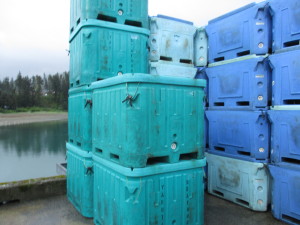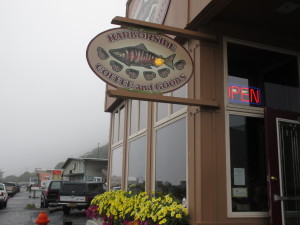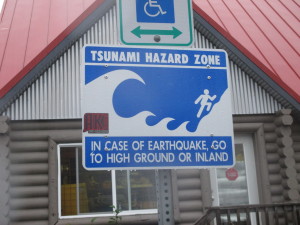Leaving Juneau, the M/V Kennicott briefly headed north through the Lynn Canal, then made an abrupt turn south into the Chatham Strait. The route continued northwest along the Icy Strait, west along the Cross Sound, and then northwest in the Gulf of Alaska along the Fairweather Mountain Range. Once we reached Elfin Cove, we were out in the Gulf of Alaska with its more rolling seas.
The scenery from Juneau to Yakutat displayed taller, snowcapped mountains and ice fields. Yakutat was the next stop on our ferry excursion. It’s the northernmost town of southeast Alaska and it’s located in Monti Bay, a deep-water sheltered port. As we arrived in port, we were unable to identify Mt. St. Elias on the western skyline, the second-tallest mountain in North America, due to fog. Yakutat is surrounded by glaciers on three sides. The Malaspina Glacier, a few miles to the town’s west, is North America’s largest Piedmont glacier.
Early settlers to Yakutat were driven from the Copper River area by Tlingit warriors. The name “Yakutat” means “the place where canoes rest.” Because of Yakutat’s deep water, protected port, it was home to many explorers from Russia, Spain, France, and England. In 1805, Tlingit warriors denied access to their fishing grounds, attacked the Russian fort. In 1889, the Swedish built a sawmill and school; by the early 1900s, they added a railroad, store, and cannery.
Although the city has only 700-some residents, it enjoys daily jet service from Seattle and anchorage. the city boasts world-class sport fishing, with all five species of Pacific salmon in the area. We saw stacks of tubs containing freshly caught, iced salmon and halibut that were waiting on the dock to be transported to the Yakutat airport on to Seattle and Anchorage for sale at restaurants.

As our ferry pulled into the Yakutat public dock, the captain announced that two wounded bears were lurking in the alder trees a few hundred yards from the ferry. Local police were encouraging ferry passengers to remain on the ferry. Standing on the bow deck, we heard shots fired and saw one bear escape and swim across the bay. Police followed the bear in a boat, but the bear managed to run off into the woods. Later, Jerry and I got off the ferry and walked around the loading dock away from the “bear zone.” We later learned the fate of the second bear–it was shot on the street in front of Fat Grandma’s Bistro.
Enroute to Whittier, we saw some glaciers; they are easily identifiable as they come right down to the water. North of Yakutat, our captain steered us close to the Hubbard glacier to view it. The Hubbard Glacier is the longest tide-water glacier.
Whittier sits at the head of the Passage Canal on the west side of Prince William Sound. The town, with a population of about 200, got its name from American poet, John Greenleaf Whittier. Our ferry made a six a.m. docking in Whittier, and we enjoyed a cup of tea at the Lazy Sea Otter. We walked under Maynard Mountain via the Anton Anderson Pedestrian Tunnel to the small downtown area. About 80% of the town’s residents live in Begich Towers, a large condominium complex. The others reside in a small apartment building downtown. Forested mountains stand directly behind Begich towers and we saw and heard several cascading waterfalls flowing down the mountain.
Whittier was hit by the 1964 earthquake, and the Buckner apartment building (still standing) was heavily damaged. The town has a nice hotel on the waterfront, a police department, and several charter fishing services.
The MV Kennicott glided through calm waters in Prince William Sound enroute to Chenega. Cloudy skies and drizzle impeded clear vision of the islands we passed. Clusters of fishing boats dotted the waters. Entering Crab Bay, we observed seafood processing boats. A snowcapped mountain and a row of pine trees framed the dock. The town consisted of a post office, a museum (closed when we were there), and a church. Chenaga is part of the Chugach National Forest. Chenega suffered tsunami damage in the 1964 earthquake, with a wave enveloping all the buildings except the school and one house; 26 residents were carried away. Today, Chenega is built on another site. The population of Chenega is about 100.
Back on the M/V Kennicott, we headed to Kodiak; the city welcomed us for a six a.m. ferry stop. Friendly baristas at the Harborside Coffee and Goods served us coffee, hot chocolate and biscotti. Business folks and fishermen filled the coffee shop, discussing their business and salmon fishing.

At nine, we visited the Kodiak National Wildlife Refuge visitor Center on Center Street. The center is well-staffed with guides who explain how area wildlife is managed. About 2/3 of Kodiak Island and 1/2 of the Kodiak Archipelago are in the National Wildlife Refuge managed by the Fish and Wildlife Service. Animal management includes population counting, tagging, and tracking. A friendly guide told us that the island and archipelago contain “every type of wildlife you can imagine that’s native to the area: Kodiak brown bears, puffins, salmon, deer, otters, ermine, and voles. Black tail deer and elk have been introduced.” Artistic displays in the center include bears feeding on salmon and a real whale carcass found by a biology teacher walking along the ocean. The teacher spotted the dead whale and reported it; Anderson Construction Company excavated a hole where the whale was buried for four years before it was dug up, disassembled, cleaned, and reassembled. The guides also shared information about salmon and Kodiak bear behavior. saying that salmon live in the ocean for most of their lives; when they are ready to spawn, they return to the rivers they came from. The bears take advantage of this easy food source; some eat only the fatty parts of the salmon–eyes, brains, and egg sacks, leaving the rest of the salmon for scavengers.
Homer–the last stop on the MV Kennicott. We highly recommend the Alaskan Marine Ferry as a way to explore the towns and waterways of coastal Alaska!
